Electric heating of an apartment or house is considered by many to be insufficiently economical. And this is a completely justified point of view, because according to statistics, the use of electricity is the most expensive method of heating.
However, in a number of situations, sufficiently effective alternatives to electric heating are simply not available, and therefore you have to use what is currently available. In such a situation, the main thing is to choose those types of electric heating that will reduce energy costs without compromising the comfortable microclimate in the house.
Direct electric heating
Use of radiators and convectors
In our article we will try to analyze the available electric heating options, determining their advantages and disadvantages. And we will start, perhaps, with the most common heaters - radiators and convectors.
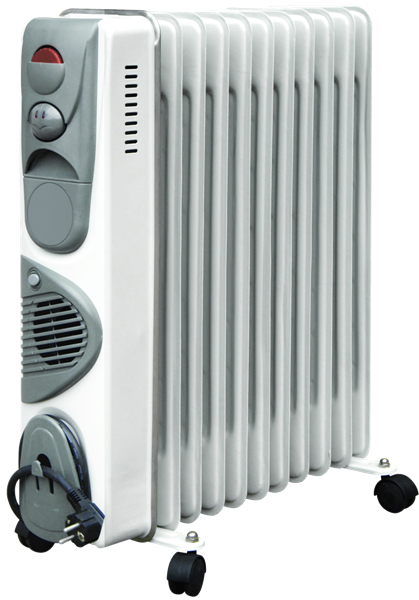
Oil radiators are widely used for local heating using electricity:
- It is a housing made of several interconnected sections (ribs), inside of which there is a mineral coolant.
- Heating elements responsible for heating it are immersed in the coolant. Most models of household oil radiators are equipped with heating elements with a power of up to 2.5-3 kW, which ensures fairly rapid heating of mineral oil.
- Under the influence of the heating element, the oil heats up to 200 0 C, but at the same time the surface of the radiator itself does not exceed the line of 90-100 0. This allows you to use such devices to heat almost any room.
The profitability of oil radiators is very doubtful, so they should not be used for general heating of the house. But as an additional source of heat, such a device will be very useful.
An alternative to oil radiators are electric convectors. They can be used for general heating of the building if it is not possible to install water heating.
- Inside the convector body there is a heating element that converts electrical energy into heat.
- From the electric heater, hot air rises upward, where it passes through the outlet openings in the housing. Most convector models today are produced with special grilles that allow you to regulate the direction of the heated air discharge.
- Under the influence of convection currents, cold air enters the convector cavity through the lower openings.
- As a rule, convectors are equipped with an automatic temperature sensor, which works on the same principle as an electric heater tap. When the passing air reaches a certain temperature, the thermostat is activated and the heating element is turned off, thereby saving energy and reducing the load on the wiring.

- Convectors can be either wall-mounted (pictured) or floor-mounted, depending on where you plan to install the heating device. A separate group consists of those that are mounted in a special recess.
Advice! Convectors built into the floor are best installed along the windows - this way they will provide the most effective protection from cold and drafts.
Unlike oil radiators, electric heating converters are successfully used for heating homes. True, such heating is still more expensive than using gas or solid fuel.
Warm floor
You can supplement your home heating system by installing a so-called heated floor. What is he like?

- Warm floor- This is a special structure made of heating cables or heating film, which is laid under the floor covering.
- Heated floor areas are equipped with temperature sensors, which are connected to a thermostat mounted on the wall of the room. Thanks to the use of such a system, we can independently regulate the heating of the apartment with electricity, setting a comfortable level of floor heating.
Advice! To ensure savings, it is necessary to lay foil thermal insulation under the heated floor. It is also important to choose flooring with sufficient thermal conductivity, otherwise the heat from the heating elements simply will not reach the room.
- You can install heated floors yourself. If you study the recommendations and videos on our website, this task will not be difficult.
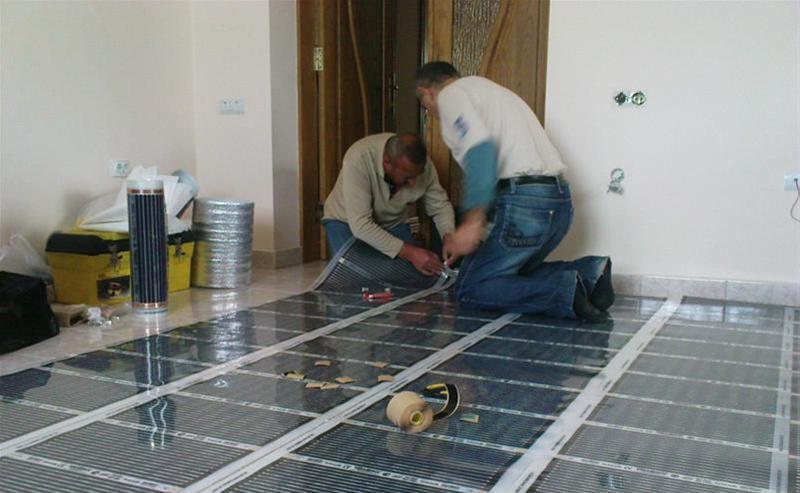
Warm floors provide heating to the room in the coldest, lower zone. At the same time, it cannot be considered a universal heating device, and therefore experts recommend using this system in combination with convectors or water heating.
Infrared heating
Another way to heat an apartment or house using electricity is to use infrared heating devices:
- An electric heating element is placed inside the IR heater, which generates infrared radiation.
- Infrared waves, coming from the heater into the room, heat not the air, but the objects they hit - the floor, furniture, etc.
- At the same time, efficiency increases significantly, because energy is not wasted, but goes exactly where it is needed in the first place.
The efficiency of modern IR heaters can exceed 90%. Thanks to this, you can achieve significant energy savings when heating a house or apartment with infrared.
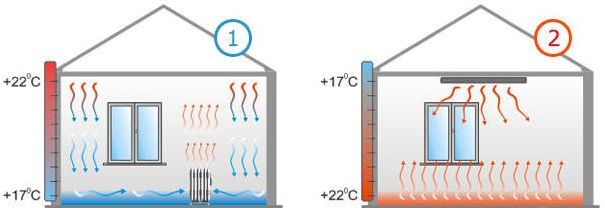
However, it should be noted that the price of the device itself is quite high. Therefore, before making a final choice in favor of infrared technologies, it is necessary to carry out cost recovery calculations.
Water heating
Heating elements new boilers
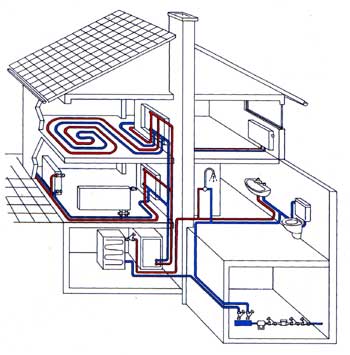
Above we talked about how you can heat an apartment using exclusively electric heating devices. However, electric water heating is still more efficient. This type of heating involves the use of hot water as a coolant, and an electric boiler or boiler is responsible for heating it to the required temperature.
Note! Domestic boilers for providing a house or apartment with hot water are unsuitable for heating. This is due to the fact that the power of their heating elements is not enough to effectively maintain the coolant temperature at the proper level.

Electric autonomous heating in an apartment or private house can use installations of various types:
- Heating elements.
- Electrode.
- Induction.
Below we will look at each of them in detail.
Heating element boilers are the most common. The principle of their operation is as follows:
- The coolant (water or antifreeze) enters the internal tank of the boiler.
- The heating element placed in the tank heats up, transferring its temperature to the water.
- Under the influence of the circulation pump, the coolant enters the circuit and is distributed to the points of consumption - radiators.
![]()
Note! The heating element is the most vulnerable point of such a boiler. It is very important that the model you choose allows for the possibility of replacing the heating element, since after several years of operation it becomes covered with scale and fails.
The operation of most boiler models is controlled automatically. This ensures savings, since the heating element heats the water only when it is needed.
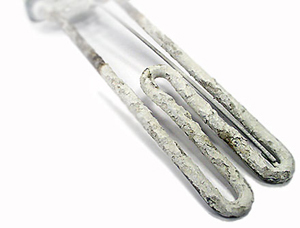
An undoubted advantage is also the lack of contact of electrical components with water. This not only increases the safety of the boiler’s operation, but also makes it possible to install automatic safety equipment that turns off the heating element in the event of an accident.
Electrode devices
A more reliable alternative to heating elements for water heating installations are electrode boilers:
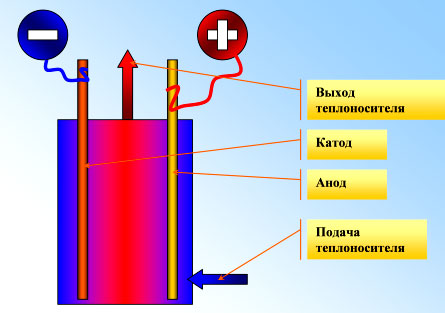
- The boiler is a relatively small container, inside of which electrodes are located.
- When the boiler tank is filled with water, a current is supplied to the electrodes, under the influence of which the water is heated.
- To ensure maximum operating efficiency of such a boiler, special preparation of the coolant is required.
An electronic boiler is more “gluttonous” because it consumes slightly more energy than a heating element. At the same time, it has a large margin of reliability, since scale formed on the electrodes cannot cause the installation to fail.
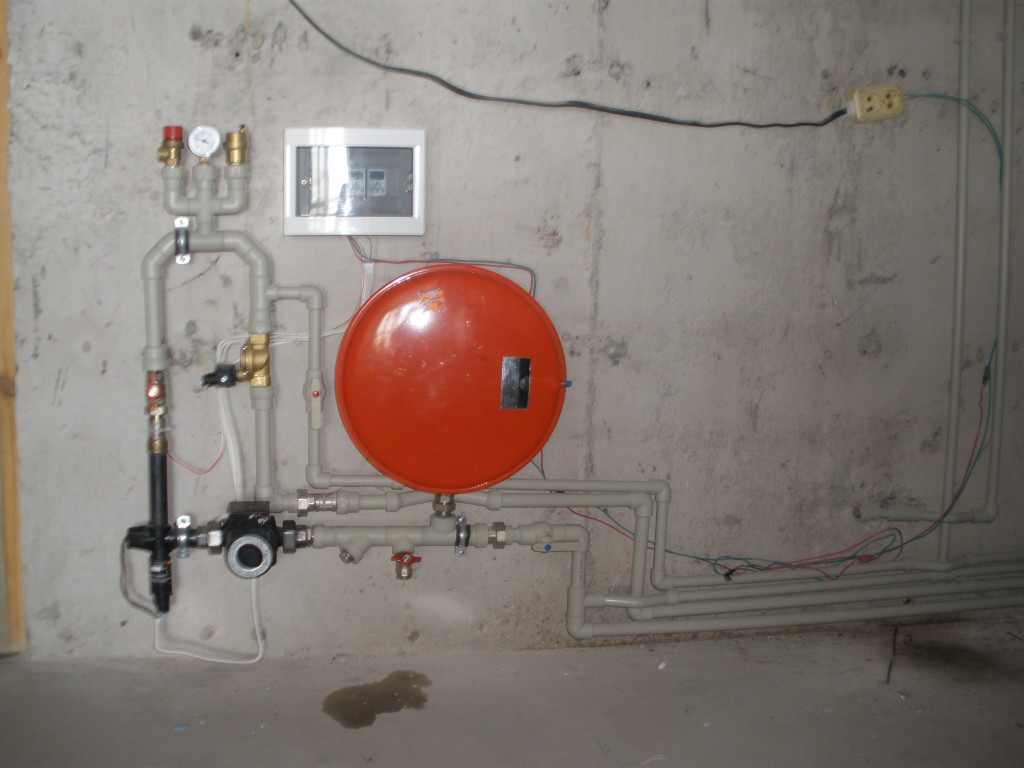
Induction boilers
And finally, the third type of boilers that provide heating from electricity is induction:
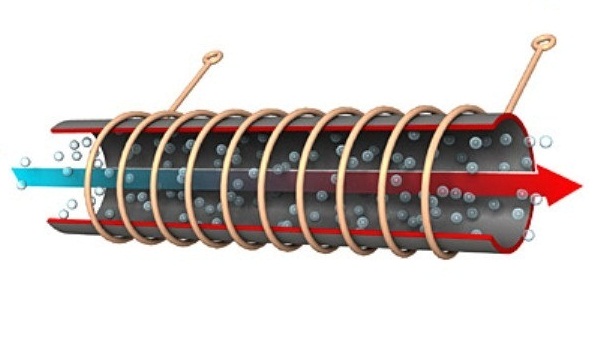
- Induction boilers have two circuits - magnetic and heat exchange.
- A special coil is placed in the magnetic circuit and generates a magnetic field that heats the liquid. The operating principle of this circuit is similar to the operating principle of an induction hob.
- Temperature redistribution occurs in the heat exchange circuit, after which the heated coolant enters the heating system of the building.
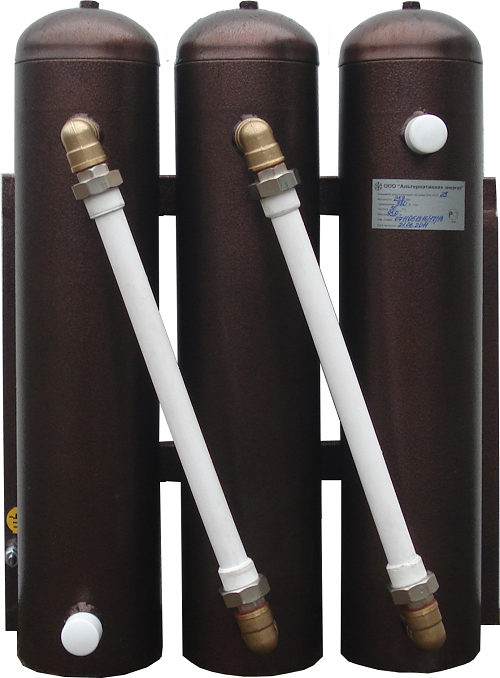
The main advantage of induction boilers is safety of use, since they do not have heating elements. At the same time, the high cost of the devices themselves, as well as the difficulty of smoothly adjusting the temperature, largely limits the spread of induction water heaters.
Advantages and disadvantages of electric heating
Electric heating - water, air or infrared - has both pros and cons.
Pros:
- Possibility of self-installation if you have the skills. If you compare the procedures for obtaining permission to install a gas boiler and to install a system of electric convectors, the choice of electricians suggests itself.
- Easy to control and adjust operation. There is no need to constantly monitor the fuel supply; simply set the desired temperature.
- Fast heating. The use of modern radiators and convectors, as well as infrared emitters, makes it possible to establish a comfortable temperature regime in the apartment within 10-15 minutes after turning on the heating.
Minuses:
- The cost of equipment is quite high, especially modern models with installed automation.
- High cost of heating itself. For example, the cost of heating 80 m2 with electricity is (at 2013 prices) about 40 thousand rubles per year, and for gas heating this figure will be in the range of 8-12 thousand. It is probably more expensive to heat only with diesel fuel or liquefied gas in cylinders.
- High load on wiring. If you simply connect an electric boiler to an outlet, then traffic jams and system overloads are inevitable.
And yet, if these shortcomings do not scare you, then heating your house with electricity can be quite effective. Moreover, it is much easier to implement electric heating with your own hands than any other.
According to the heat standards established in our country, the average temperature in apartments should be within +18...+20 degrees. In this case, the heat supply must be uninterrupted throughout the entire heating season. But what to do if utility services fail to cope with their responsibilities and the batteries remain cold even in the most severe frosts. Where should I complain about the lack of heating? Be sure to report this to the emergency dispatch service. They are required to schedule an inspection, and if necessary, several, during which the temperature in the room is measured. Based on these indicators, a report on the lack of heating is drawn up, which gives you the right to recalculate the payment for heat. In addition, you have the right to demand that the cause of the lack of heat be eliminated.
Mold in the apartment.
Lack of heating and insufficient ventilation in the room, especially in the off-season, leads to increased humidity and, accordingly, the appearance of mold. Naturally, the question arises - where to go if mold appears in the apartment?
According to sanitary and epidemiological standards, permissible air humidity values in residential premises should be:
- 30-45% in the cold season, maximum value -60%;
- 30-60% - in warm weather, when the room temperature reaches 26 degrees.
The exception is the kitchen, for which such standards do not exist.
The appearance of mold on walls, furniture, etc. is the result of high humidity. Solving this problem requires immediate action, since the fungus has the ability to negatively affect your health, namely:
- Development of asthma and allergies;
- Suffocation;
- The appearance of conjunctivitis;
- Respiratory problems, namely: bronchitis, laryngitis and others.
To determine the humidity in a particular apartment, you must contact the specialists of the Center for Hygiene and Epidemiology. 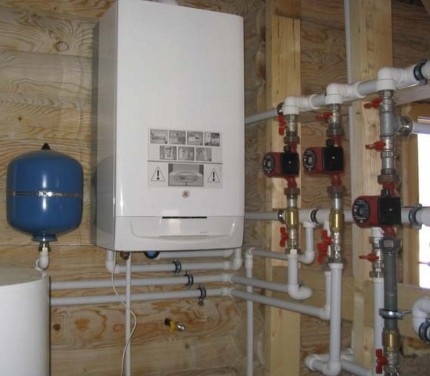
If your fears are justified, and the air humidity significantly exceeds permissible standards, you have the right to contact the housing department by telephone or in writing and demand that all problems with the ventilation system be corrected
Individual electric heating in the apartment as an alternative to centralized heating.
Every day, autonomous electric heating devices in apartments are in increasing demand. There are many positive factors leaning in favor of this particular method of heating a home. The main criteria are: 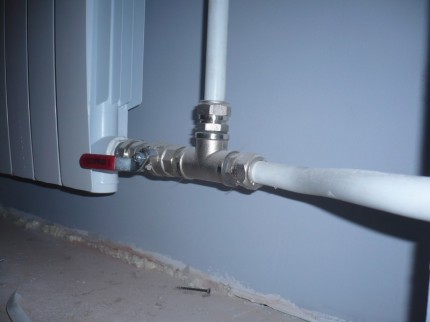
- Unsatisfactory performance of utilities providing heating services;
- The relatively affordable cost of such equipment and its quick payback;
- Efficiency, i.e. the ability to independently regulate the temperature depending on weather conditions;
- There is no need for additional heating devices that consume a lot of electricity;
- Easy to install and maintain.
The most economical and affordable today are stationary energy-saving heating systems. One such heater is able to heat a room up to 750 sq.m., while having significantly low energy consumption. 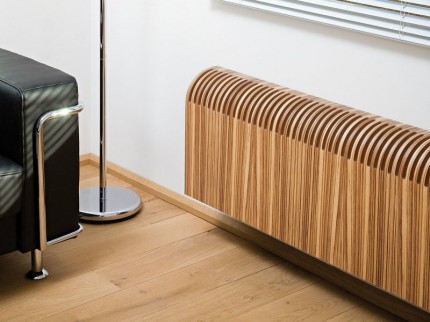
Electric heating is divided into several types, each with its own pros and cons.
Central water heating
Central water heating. This type of heating is characterized by the installation of a central electric boiler and the installation of radiators in all rooms. The principle of its operation is to heat water with an electric boiler, which flows through radiators, heating them. To achieve higher heating limits for radiators, you can replace water with transformer oil.
Heating using autonomous water heaters. It has a slight difference from the first method, namely: each radiator has its own electric heater inserted with heating adjustment. In this case, you do not need a boiler and pipes. When choosing a water heater, give preference to a heater with a larger usable area, this provides more efficient heating of the liquid.
Electric heaters
Electric heaters. These include different types of electric fireplaces, as well as infrared and ultraviolet heaters. These types of heaters transfer heat energy through radiation. Heat is felt only if you are in the radiation zone. The air in the room is heated by surrounding objects. 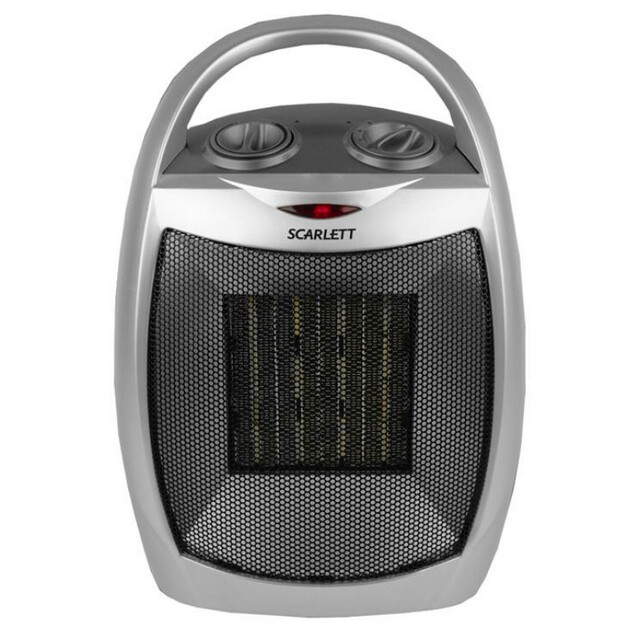
A fan heater is installed in the room to heat the air mass. Its operating principle is that with the help of a fan, air passes through a hot spiral or heating element. At the same time, the air heats up and, circulating around the room, carries heat.
Built-in electric heaters
Built-in electric heaters. Underfloor heating systems have received a great deal of attention among these products. They create a feeling of warmth and comfort when in contact with the floor.
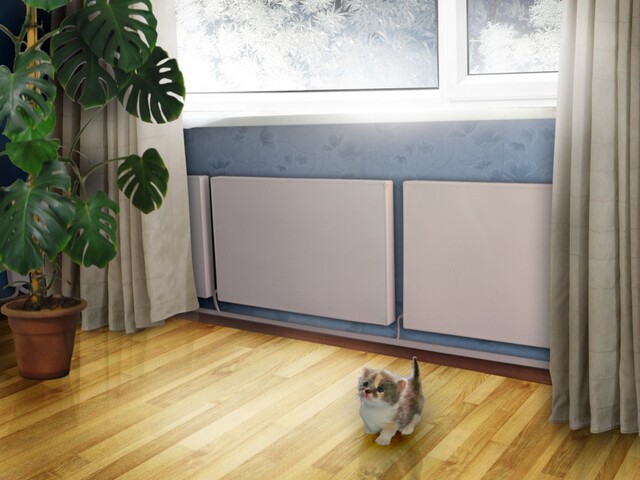 Convector heating. It consists of simple installation of convectors in rooms; they are calculated by power depending on the volume of the room. They have smooth heating control and overheating protection. Splash-proof types are produced for wet rooms. The air is heated using spirals and heating elements. Convectors are safe and operate unattended. Service life is 25 years.
Convector heating. It consists of simple installation of convectors in rooms; they are calculated by power depending on the volume of the room. They have smooth heating control and overheating protection. Splash-proof types are produced for wet rooms. The air is heated using spirals and heating elements. Convectors are safe and operate unattended. Service life is 25 years.
Electrical heating with electrically conductive paper
Electrical heating using electrically conductive paper. This is a very interesting and simple heating option. On carbon fiber paper you need to stick electrode strips made of foil, which we connect to the electrical network. The heater can be glued to the wall. The size of the paper material must be chosen so that the temperature is no more than 50°C. This type of paper is in short supply. Another drawback is that this type of heater is afraid of water; if it gets in, the paper quickly burns out. Various conductive paper paintings are commercially available, but their price is high for heating a whole house.
Each option has its own advantage. All you have to do is decide on the appropriate method of electric heating.
Making a fan heater with your own hands
The efficiency of the fan heater is very high, but the spiral dries out the air and burns out oxygen, which creates a not very comfortable atmosphere. But this device will warm the air very quickly and will be indispensable in the country house, as well as in the garage.
For production we will need:
- galvanized sheet 0.5 mm thick;
- an electric motor with an impeller (as an option with an unnecessary vacuum cleaner);
- a spiral consisting of nichrome with a power of 1.5 kW (available on the market);
- a thick piece of slate;
- 2 circuit breakers, one 25 amp for the coil, the other for the 6 amp motor;
- electrical cord with plug;
- about a dozen bolts, nuts, washers.
We make a galvanized pipe with a diameter of 200 - 250 mm, on one side we install an electric motor with an impeller, and on the other side we attach a spiral located on strips of slate. We connect the electrical wire to the motor and the spiral through the appropriate circuit breakers. The fan heater is ready for use.
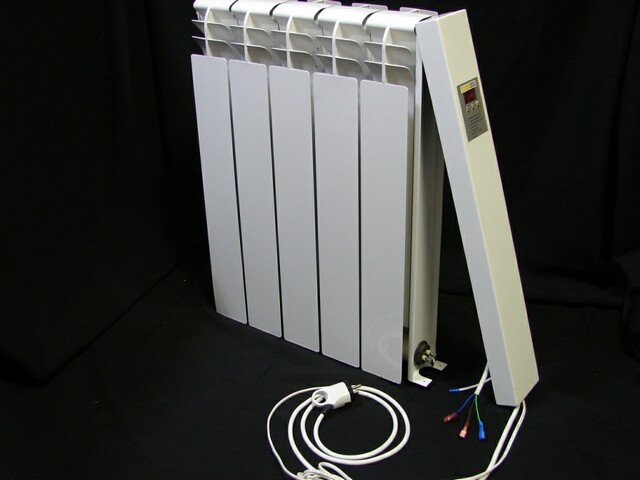 A water convection electric heater consists of a container and a heating element that heats the water; it is more difficult to make it yourself, but the circuit is simpler than that of a fan heater.
A water convection electric heater consists of a container and a heating element that heats the water; it is more difficult to make it yourself, but the circuit is simpler than that of a fan heater.
- Making containers. It is best to weld a radiator suitable for you from pipes.
- Heating elements are easy to find on the market with built-in adjustment and a shutdown relay.
- We will mount a heating element at the bottom of the radiator (you need to cut a thread in the radiator to screw in the heating element).
- We connect the heating element to the electrical part.
- Fill the radiator with water or oil.
The electric heater is ready for use.
Making an electric spiral at home
To make a spiral, we will need a nichrome thread and an electric drill with a clamped rod 600 mm long. with a diameter of 4 mm. As you may have guessed, the thread is wound around a rod.
Connecting electric heaters to the electrical network
Electric heaters are calculated by power: per square meter of room area, the power should be 100 watts. For a room 4x4 meters, the heater power should be at least 1.6 kW. From the above it is clear that the total power of the heaters is considerable. The electrical wiring may not withstand such a load, so we recommend connecting separate wiring from the input to each heater, calculating the wire cross-section based on the power consumption.
It is worth considering that a heater made by a quality manufacturer will be much better than a DIY one. By making an electric heater, you gain in price, gain the most important and invaluable experience, but lose in the quality and safety of this device.
Recently, many people are giving up central heating. This is usually due to the fact that there is a need to buy heaters, since the temperature in the rooms is very low. In addition, the central highway can very often fail. Many people do not want to depend on the state and therefore install electric heating in their apartments.
With its help, you no longer need to wait for the heating to be turned on. Now you decide for yourself when to turn on the heating. In this article you will learn how to make electric heating in an apartment with your own hands. You will also learn how to install it and which heaters are best to use.
Need to know!
Electric heating in an apartment will cost more than water heating. This is usually due to the high power of the heaters. Despite this, if you correctly calculate the power of the heaters, then you can use an individual heating system without extra costs. Now you need to familiarize yourself with the heaters that you should choose.
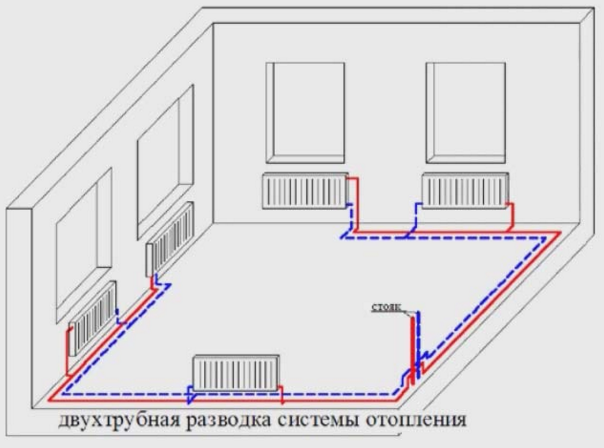
Before installing autonomous heating in your apartment, you should familiarize yourself with its pros and cons. The advantages of this type of heating include:
- Easy to install.
- Small dimensions of the system.
- High productivity.
- There is no need to obtain additional permits.
The main disadvantage is the high price of utilities. Also, if the apartment has old wiring, then it will need to be replaced. If you are planning to do this, then this information will be useful.
The autonomous electric heating system for an apartment must be selected individually. If you have a one-room or two-room apartment, then you can use the “warm floor” system. If necessary, it can be combined with other heating systems. Thermal radiation will be directed from top to bottom.
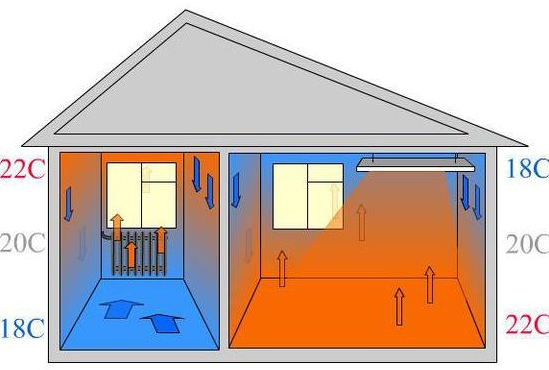
Heating an apartment with electric convectors does not dry out the air and does not have a negative effect on humans. On many forums you can find negative reviews about infrared heaters. The underfloor heating system in the apartment is considered popular. Almost anyone can install it. It is best to use thermomats in an apartment.
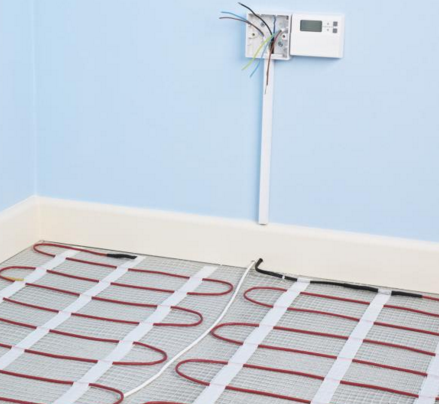
If you live in a three-room or four-room apartment, then it is better to use water pipes for heating. This is due to the large total area of the rooms. Individual heating for an apartment will be quite expensive. If you install electric heating in your apartment, then you should take care of its power. If you want to get an autonomous and economical system, then you need to make water radiators that will be powered by a heated floor. This can also be done using heated floors.
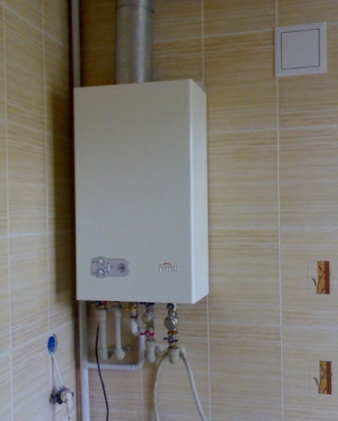
Installation of electric heating in an apartment
To correctly install autonomous electric heating in an apartment with your own hands, we recommend that you consider the following tips:
- You need to install convectors under the windows. This will avoid drafts and compensate for heat transfer.
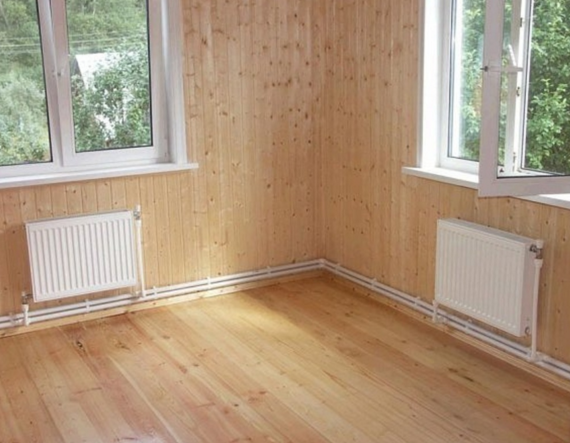
- When choosing convectors, it is better to give preference to the in-floor option.

- The wiring must be grounded. You cannot connect an electric boiler without grounding.
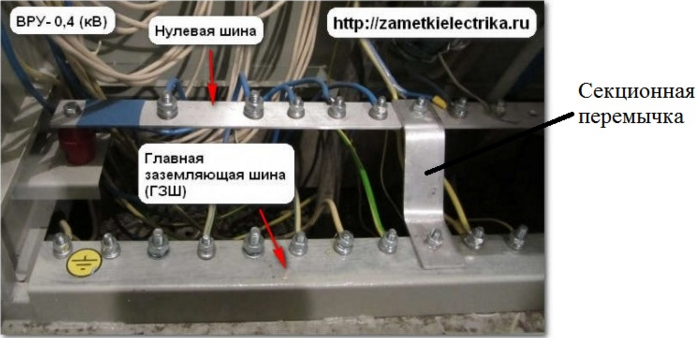
- It is recommended to install heated floors in the bathroom or kitchen.
- It is necessary to install thermostats only in cold places.

- Electric heating in the apartment does not involve the use of oil heaters. These devices are best used for summer cottages.
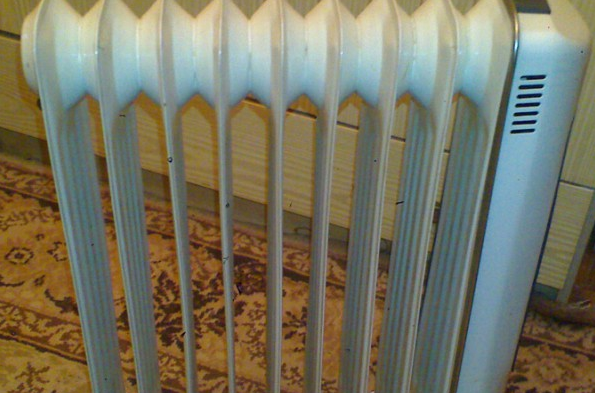
How to save on electricity in an apartment?
If you don’t know how to make electric heating in an apartment cheap, then you need to read our article. When installing heating it is necessary to use thermostats. Temperature regulators can save significant money. Temperature regulators allow you to set the optimal temperature.
Recently, many residents of apartment buildings are switching from a central heating system to an autonomous one. This is due to the fact that when using heat from housing and communal services, you can wait a long time for the heating season to begin, or the temperature in the apartment is not high enough and you still have to buy additional heaters. In addition, the central pipe line in old panel houses often fails: pipes are broken and constantly changed, leaving the owners only to wait for the heat to be restored again. In order not to depend on government services, you can make electric heating in your apartment with your own hands and independently regulate the temperature of your home. We will talk further about how to carry out installation and what heaters to use for this!
Keep in mind!
It should be noted right away that electric heating in an apartment will cost much more than city water heating. This is due to the high power of heaters and high electricity tariffs. Despite this, if you correctly calculate the power of electric heaters, set an economical operating mode and correctly place the devices in the rooms, you can significantly save on your light bill and use an individual heating system without overpayments. Next, we will tell you which electric heaters are best to choose and where to install them correctly for efficient operation.
It is equally important to immediately highlight the pros and cons of electric heating in the apartment. As for the advantages, these are, of course, ease of connection, high efficiency of heaters, durability and small dimensions, which significantly saves free space in the room. In addition, for the installation of electric heating there is no need to obtain additional permits, which take a lot of time and nerves. The disadvantages, as you understand, are the high material costs for utilities and replacement of wiring, if necessary.
How to connect radiators without water pipes?
Application of electric radiators
Choosing the right system
Depending on the area of the living space and the quality of wall insulation, a suitable option for autonomous electric heating of the apartment is selected. If you are the owner of a one-room or two-room Khrushchev house, a system in combination with electric convectors or IR panels can handle this. Combinations with infrared heaters are more profitable and efficient, because... thermal radiation will be directed from top to bottom and all the heat will circulate in the lower part of the room. Heating an apartment with electric convectors is better only because the devices do not dry out the air and do not have a negative impact on human well-being. There are many reviews that IR heaters with constant radiation have a negative effect on health, which is their disadvantage. 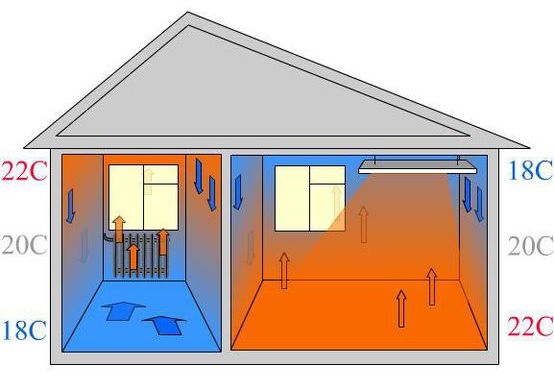
You can find the rest in the corresponding article. Yet, as statistics show, in 2017 such devices are actively purchased for household use!
As for electric underfloor heating, it is indeed very popular and effective. Anyone can do it, even an electric kettle. In addition, the material can only be used to make heated paths in the apartment, and not to lay film over the entire floor area. This heating option will have a positive effect on energy savings and at the same time will effectively warm the room. 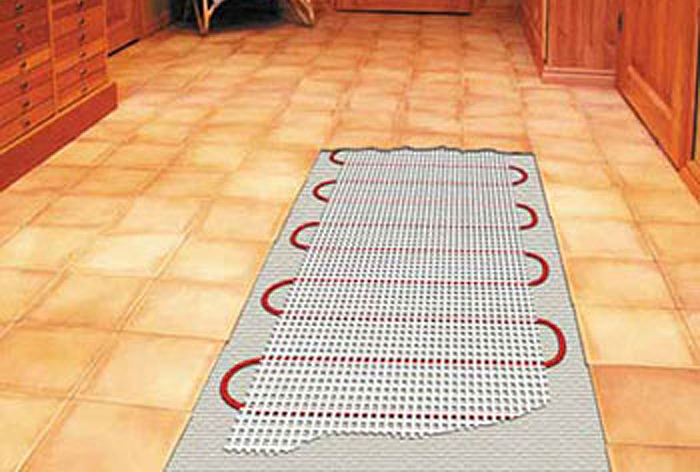
If you live in a three-room or four-room house, then it would be more reasonable to use the connection of electric water heating in the apartment. This is due to the large total area of the rooms, which will require a full-fledged, powerful heating system. For example, if the area is 130 sq. m., with the calculation of 1 kW/10 sq. m. it will be necessary to install no less than a 13-kilowatt bundle of electric heaters. Of course, in winter you will spend a lot of money on the operation of an individual electric heating system. In addition, to use this option, the wiring must be powerful and able to withstand high current loads. In this case, you cannot do without it, which, again, will hit your budget. At the same time, if you use water radiators powered by an electric boiler, the heating will be autonomous and less expensive, which will allow you to “kill two birds with one stone.” 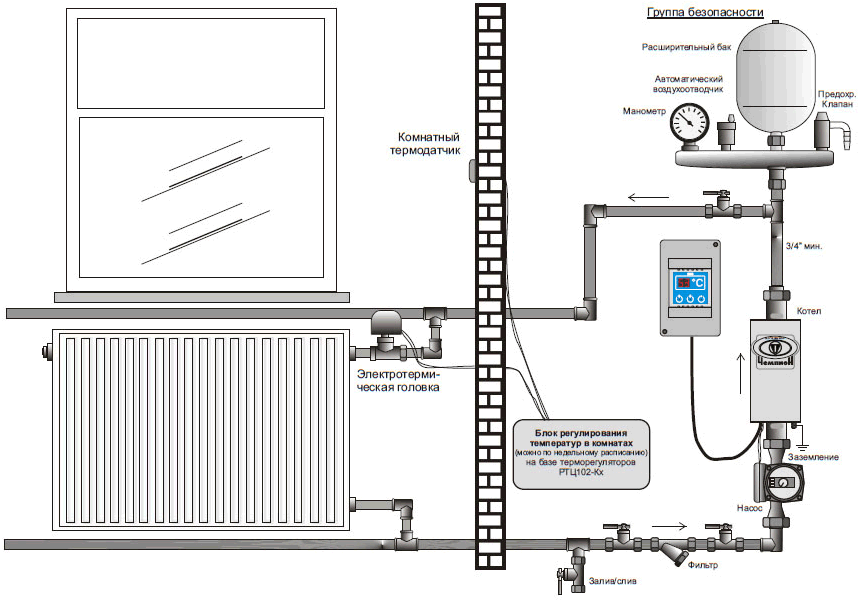
In order for you to correctly install autonomous electric heating in an apartment with your own hands, we recommend taking into account the following tips from experts:
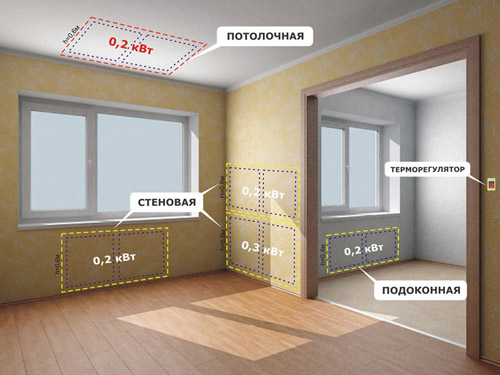
How to save on electricity
Well, the last thing I would like to talk about is how to make electric heating in an apartment cheap, but at the same time effective. The first thing you should consider is that without thermostats, installation will not be profitable. It is temperature controllers, and especially electronic ones, that allow you to set the optimal temperature without overpaying for excess heat.
Another way to save money is to connect multi-tariff energy meters. We looked at it with you. Let us note once again that the benefits may be different for each region. Still, there are more positive reviews about such devices. Owners of two-tariff electric meters recommend turning on the heaters at night so that during the day, while everyone is working, the autonomous heating is turned off. In this way, you can save up to half of the electricity consumed, which makes autonomous electric heating in the apartment not very expensive. If you decide to install such meters, be sure to analyze the 2017 tariffs on the Internet for your city, based on which you will understand whether such devices are profitable or not. 





